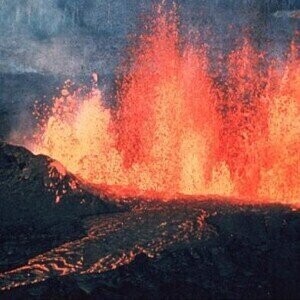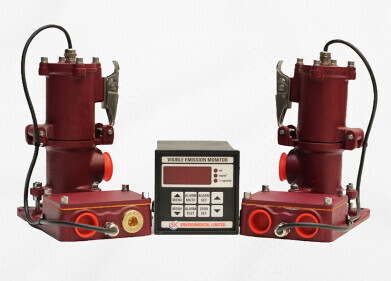Air Monitoring
What particles do volcanic eruptions emit?
Jan 16 2024
Volcanic eruptions are one of nature's most powerful events, captivating and terrifying in equal measure. While their immediate destructive potential is evident, volcanic emissions also have far-reaching impacts on the atmosphere and air quality. Let's explore the range of air pollutants and particles emitted by volcanoes, exploring their nature, composition, and the implications for the environment and climate.
Volcanic gases and particles consist of a complex mixture of compounds, each with unique properties and effects. One of the primary gases emitted by volcanoes, SO2 can have significant environmental and climatic impacts. Upon release, it reacts with atmospheric water and oxygen to form sulfate aerosols, contributing to acid rain and respiratory problems in humans. These aerosols also have a cooling effect on the Earth's climate by reflecting solar radiation back into space. Volcanoes release substantial amounts of CO2, a well-known greenhouse gas contributing to global warming. While volcanic CO2 emissions are relatively small compared to anthropogenic sources, they play a critical role in Earth's carbon cycle. CO, though less abundant, can also be emitted and poses a threat due to its toxicity and contribution to ground-level ozone formation. The most abundant volcanic gas, water vapor, plays a complex role in climate dynamics. While it's a potent greenhouse gas, its overall impact depends on the altitude and latitude of the emission and subsequent cloud formation processes. Hydrogen Sulfide (H2S) and Hydrogen Chloride (HCl) contribute to acid rain and can have deleterious effects on human health, agriculture, and ecosystems. Volcanic ash, consisting of fine particles of volcanic rock and glass, poses significant hazards. It can disrupt aviation, damage machinery, and when inhaled, cause respiratory issues. The size distribution of these particles, from fine to coarse, determines their atmospheric residence time and potential for long-range transport.
Volcanic emissions significantly influence air quality and climate, both locally and globally. Eruptions can lead to immediate deterioration in air quality near the volcano. High concentrations of SO2, H2S, and particulate matter can cause respiratory problems, eye irritation, and exacerbate pre-existing health conditions. In areas with volcanic activity, a type of air pollution known as 'vog' can form. It's a mixture of volcanic gases and aerosols, including sulfuric acid droplets, which can reduce visibility and affect respiratory systems. Major eruptions can inject sulfur gases into the stratosphere, forming an aerosol layer that reflects sunlight and cools the Earth’s surface. This phenomenon was observed after the 1991 eruption of Mount Pinatubo, which led to a global temperature decrease of about 0.5 °C. Halogen gases like HCl and bromine compounds released in eruptions can reach the stratosphere, where they contribute to ozone depletion. The extent of this impact varies based on the eruption's magnitude and the chemical composition of the emissions.
Advancements in remote sensing and ground-based monitoring techniques have greatly enhanced our ability to study and understand volcanic emissions. Satellites equipped with spectrometers can detect and quantify gases like SO2 and CO2 in volcanic plumes, even from remote or inaccessible volcanoes. This technology allows for real-time monitoring of emissions and their dispersion patterns. Near volcanoes, ground-based sensors provide detailed measurements of gas concentrations and particulate matter. Drones equipped with sensing equipment have become valuable in sampling volcanic plumes, especially in hazardous or unreachable areas. Data from these observations feed into climate and air quality models, helping to predict the short-term and long-term impacts of volcanic emissions. These models are crucial in understanding the role of volcanoes in the Earth's climate system and in formulating mitigation strategies for air quality issues.
While significant progress has been made in understanding volcanic emissions, challenges remain. Predicting the timing and magnitude of volcanic eruptions and their subsequent emissions remains a challenge. Enhancing predictive models through better understanding of volcanic processes is a key area of ongoing research. The long-term climate effects of volcanic emissions, particularly in the context of anthropogenic climate change, are complex and not fully understood. Continued research is needed to unravel these interactions and their implications for future climate scenarios. More research is needed to understand the health impacts of long-term exposure to low levels of volcanic gases and particulates, especially in communities living near active volcanoes.
Volcanic emissions play a significant role in shaping our atmosphere, affecting air quality, climate, and human health. As our understanding of these emissions improves, so does our ability to predict their impacts and develop strategies to mitigate their adverse effects. Ongoing research and monitoring are crucial in this endeavour, offering insights not just into volcanic processes but also into broader atmospheric and environmental phenomena.
Digital Edition
IET 34.2 March 2024
April 2024
Gas Detection - Biogas batch fermentation system for laboratory use with automatic gas analysis in real time Water/Wastewater - Upcycling sensors for sustainable nature management - Prist...
View all digital editions
Events
May 06 2024 Minneapolis, MN, USA
May 13 2024 Munich, Germany
May 15 2024 Lund, Sweden
May 15 2024 Frankurt-am-Main, Germany
May 20 2024 Columbus, OH, USA


















